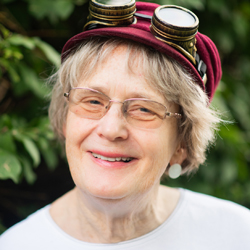
The dining room where novelists Charlotte, Emily, and Anne Brontë studied and later honed their craft together.
I didn’t know Patrick Brontë, father of famous authors Charlotte, Emily and Anne, was a homeschool hero.
But that’s what I figured out on a recent visit to the Brontë home in Haworth, Yorkshire, U.K.
Brontë was an Irish Anglican from the north of Ireland. His father was a poor laborer. Brontë had ambition. So as a young man he came to England, got a scholarship to study at Cambridge, got a bachelor’s degree, and became an Anglican clergyman. He also changed his name from Irish Brunty to Brontë, the Greek word for thunder, perhaps to hide his origins. But he always spoke with an Irish accent, and indeed his children did too.
Brontë married and served at several churches. Eventually he came to serve All Saints church in Haworth, West Yorkshire. Along the way he and his wife Maria had six children. But she died when the youngest, Anne, was five years old.

Me and the Bronte Parsonage
Who would care for and teach the children? His wife’s sister became the children’s caregiver, an arrangement that lasted the rest of her life. But, being female in that culture, her education was wanting. She wasn’t to be their teacher.
Initially he sent four oldest off to boarding school. But the school (immortalized in Charlotte’s novel Jane Eyre as the horrible Lowood School) starved its students and treated them badly. In fact, the two oldest came home in 1825 … and died.
I suppose that shocked him into changing his habits. He became the teacher. While still a clergyman, he led them through the classics and all the things that educated men would study. His four pupils were Charlotte, Emily, and Anne, as well as their brother Branwell. Since the girls weren’t allowed to check out books from the town library, Branwell checked out books for them all.
They created a shared imaginary world as backdrop for their early stories. They weren’t alone in doing this: a century later, C.S. Lewis and his brother Warnie did the same thing as children.
A housekeeper remembered later how the grown young people would walk and walk around the table, working on their stories together. They also sat together, papers strewed on the table. Emily drew a picture of that in her diary.
Writers need other writers or editors, to help them hone their craft. In bygone days, a publisher’s editor often served in this way. Now the three Bronte novelists, and sometimes their brother, formed a writer group. It must have been like so many writer groups I have enjoyed, where everyone could get helpful feedback from others. This is how the three female authors were able to craft ground-breaking novels, as well as hold their own in literary social circles.
This creative life didn’t last for Emily, Anne, and Branwell, who each died at the age of 30 or so. Haworth was a toxic place to live, full of typhus, tuberculosis, and sickness caused by poor sanitation. Charlotte lived a bit longer, to age 39. But Patrick Brontë died at 84. He long outlived all of his children.









That is a very interesting story. Thank you for sharing it.